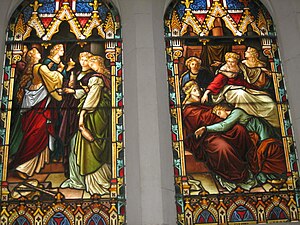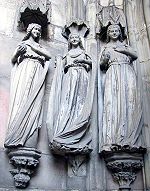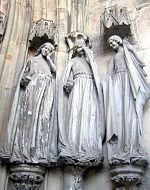
Ten Virgins from Peter von Cornelius
The Parable of the Ten Virgins , or the Wise and Foolish Virgins, is a parable told by Jesus in the gospel of Matthew (Matthew 25:1-13)[1]. In it, the five virgins who are prepared for the bridegroom's arrival are rewarded and the five who are not prepared are excluded. The parable has a clear apocalyptic theme: be prepared for the day of reckoning.
In the Parable of the Ten Virgins the story is told by Jesus of a party of virgins given the honor of attending a wedding. Each of the ten virgins is carrying a lamp as they await the coming of the bridegroom. Five are wise and bring an extra jar of oil for their lamps. Five are foolish and take no extra oil with them. The bridegroom is late in coming; the foolish virgins ask the wise ones for spare oil, but the others refuse, saying that they might then not have enough. While the foolish virgins are away buying more oil, the bridegroom arrives. The wise virgins are there to welcome him and the foolish ones arrive too late and are excluded.
It was one of the most popular parables in the Middle Ages with enormous influence on Gothic art, sculpture and the architecture of German and French cathedrals.

Foolish virgins in Lübeck

Wise virgins in Lübeck
Then shall the kingdom of heaven be likened unto ten virgins, which took their lamps, and went forth to meet the bridegroom.
And five of them were wise, and five were foolish
They that were foolish took their lamps, and took no oil with them:
But the wise took oil in their vessels with their lamps.
While the bridegroom tarried, they all slumbered and slept.
And at midnight there was a cry made, Behold, the bridegroom cometh; go ye out to meet him.
Then all those virgins arose, and trimmed their lamps.
And the foolish said unto the wise, Give us of your oil; for our lamps are gone out.
But the wise answered, saying, Not so; lest there be not enough for us and you: but go ye rather to them that sell, and buy for yourselves.
And while they went to buy, the bridegroom came; and they that were ready went in with him to the marriage: and the door was shut.
Afterward came also the other virgins, saying, Lord, Lord, open to us.
But he answered and said, Verily I say unto you, I know you not.
Watch therefore, for ye know neither the day nor the hour wherein the Son of man cometh.

A depiction of the Parable of the Ten Virgins on a stained glass window in Scots' Church, Melbourne
Story[]
The Parable of the Ten Virgins is a narrative attributed to Jesus. It is found in the 25th chapter of the Gospel of Matthew. Ten young virgins are gathering in anticipation of a wedding. They are awaiting the arrival of the bridegroom. They know that he was coming at some time during the night. But his coming is delayed until the dark hours after midnight. When he finally does arrive, some of the virgins are out of oil and some are not.
The focus of the story is on the lamps each one of the virgins carries and on the available supply of oil. As the midnight hour approaches, the lamps of all ten of the virgins begin to flicker and burn low. Five of the virgins have prudently made preparations for this. These five "wise" virgins have brought an extra jar of oil with them. When the cry of the bridegroom's friend comes at midnight, these virgins are ready. They rise up from their slumbers, recharge their lamps, and go with the bridegroom.
For the other five virgins, it is a different story. They have not prepared, and their oil has run out. They try to borrow oil from the others. But the others refuse to share, saying that there would not be enough. The virgins with empty lamps are unable and go out into the darkness to meet the bridegroom. They run off to get more oil, but by then, the bridegroom no longer wants them.
Interpretations[]
Some Christian commentators consider the ten virgins parable to be a story about bridesmaids, rather than virgins. However, if this were so, then the focus would be with their relationship with a bride, rather than with a bridegroom. The most common interpretation, and the one most favored by the Roman Catholic Church, is that the virgins represent the church itself. Their virginity represents their purity of heart and soul. The bridegroom represents either the Second Coming of Jesus or any other form of a judgment day (such as one's own death).
Some branches of Christianity believe this parable has prophetic significance. Like the virgins, the church is considered a company of people in a covenant commitment (or betrothal) with a coming Bridegroom (i.e., the Second Coming). The prophetic interpretation of this parable is based on a warning to be prepared for the Second Coming.
David O. McKay, the ninth president of The Church of Jesus Christ of Latter-day Saints said this parable refers particularly to members of the LDS Church as they are encouraged to prepare for the Second Coming of Jesus Christ.
A few Bible commentators doubt that Jesus ever told this parable and that, instead, it is a parable created by the very early church. A large majority of fellows on the Jesus Seminar, for example, designated the parable as merely similar to something Jesus might have said or simply inauthentic ("gray" or "black")[2]. Eta Linnemann, in her book Jesus of the Parables, argued that the parable was a creation of the early church to encourage the faithful to continue to be prepared for the end of the world. The delayed parousia, i.e. the delayed coming of the Son of Man, may have been causing people to lose faith. She argued that it was likely that this was an attempt, perhaps spoken through prophetic utterance, to preserve the expectation of the return of Christ but with patience, not in the original state of high tension which likely existed at the earliest stages of the church's life.
Some commentators believe that the parable reflects the practice of polygamy, since the women are specifically referred to as virgins, they go with the bridegroom when he arrives, and no other bride is ever mentioned in the story.
Spencer W. Kimball discussed the difference between the 5 wise and 5 foolish virgins and why they could not share the oil. "This was not selfishness or unkindness. The kind of oil that is needed to illuminate the way and light up the darkness is not shareable. How can one share obedience to the principle of tithing; a mind at peace from righteous living; an accumulation of knowledge? How can one share faith or testimony? How can one share attitudes or chastity.... Each must obtain that kind of oil for himself.... In the parable, oil can be purchased at the market. In our lives the oil of preparedness is accumulated drop by drop in righteous living. Fasting, family prayer... control of bodily appetites, preaching the gospel, studying the scriptures-each act of dedication and obedience is a drop added to our store. Deeds of kindness, payment of offerings and tithes, chaste thoughts and actions, marriage in the covenant for eternity-these, too, contribute importantly to the oil with which we can at midnight refuel our exhausted lamps." (Faith Precedes the Miracle, p.255)
Sculpture[]

Wise virgins appear with Christ on Strasbourg Cathedral

Foolish virgins appear with the Tempter on Strasbourg Cathedral

Three wise virgins showing their joy at Magdeburg Cathedral

Three foolish virgins showing their sorrow at Magdeburg Cathedral
There are sculptures of the ten virgins in:
- France
- at Amiens Cathedral, the Cathédrale Saint-Étienne d'Auxerre, in Bourges, at Notre-Dame of Laon, Notre Dame de Paris, Notre-Dame de Reims, in Sens and at Notre-Dame de Strasbourg
- Germany
- in Freiburg, Lübeck and at the Erfurt Cathedral and the Cathedral of Magdeburg
- Switzerland
- in Basel, Bern
Painting[]
- The ten virgins also occur in paintings in Northern Europe, as in churches on the Swedish Isle of Gotland.
- Finnish painter, Tove Jansson is known to have created an altarpiece with the ten virgins theme in Teuva Church.
- In the 19th century the religious movement of artists of the Nazarene Art took up this theme.
Drama[]
- Sponsus, a mid-11th-century play in both Latin and Occitan
- Ludus de decem virginibus, a German play first performed 4 May 1321
- A Dutch play of the late Middle Ages
Fictional works[]
- The ten virgins are carved on the doors of Kingsbridge cathedral, in Ken Follett's World Without End, set in the Late Middle Ages.
Worship and music[]
The parable is the gospel reading for the 27th Sunday after Trinity in the traditional Lutheran lectionary. In the Revised Common Lectionary, the parable is read in Proper 27 (32nd Sunday in Ordinary Time).
Its message was formed into a Chorale, Wachet auf, ruft uns die Stimme, by Philipp Nicolai, which Johann Sebastian Bach used for his cantata of the same name (BWV 140): Wachet auf, ruft uns die Stimme.
In the Armenian Orthodox Church the parable is the main theme of Holy Monday. A special Church service enacting the parable of the ten virgins is celebrated on Tuesday evening of the Holy Week.
The song "Drop by Drop" by Kurt Bestor, Stephen Jones, Jenny Frogley and Ron Williams talks about a personal application of the parable.
In the song "Carpet Crawlers" by Genesis, a reference is made to the wise and foolish virgins.
The parable also influenced the Arizona-based girlpunk band The Foolish Virgins. [3]
References[]
- ↑ The Holy Bible, King James Version
- ↑ Funk, Robert W., Roy W. Hoover, and the Jesus Seminar. The five gospels. HarperSanFrancisco. 1993. pages 254
- ↑ http://www.myspace.com/foolishvirgins
There is also a ballet "The wise and the foolish virgins" by the Swedish composer Kurt Atterberg (1887-1974), written in 1920.
External links[]
- Some or all of this article is forked from Wikipedia. The original article was at Parable of the Ten Virgins. The list of authors can be seen in the page history.
- The Parable of the Ten Virgins in Context
- An audio and article of the Parable of the Ten Virgins
| |||||||||||||||||||||||||||||||||||||||
| Wikimedia Commons has media related to: Ten virgins |
